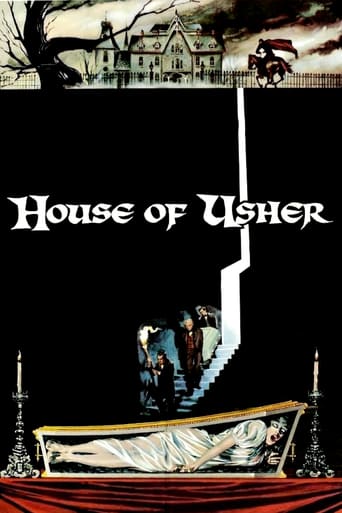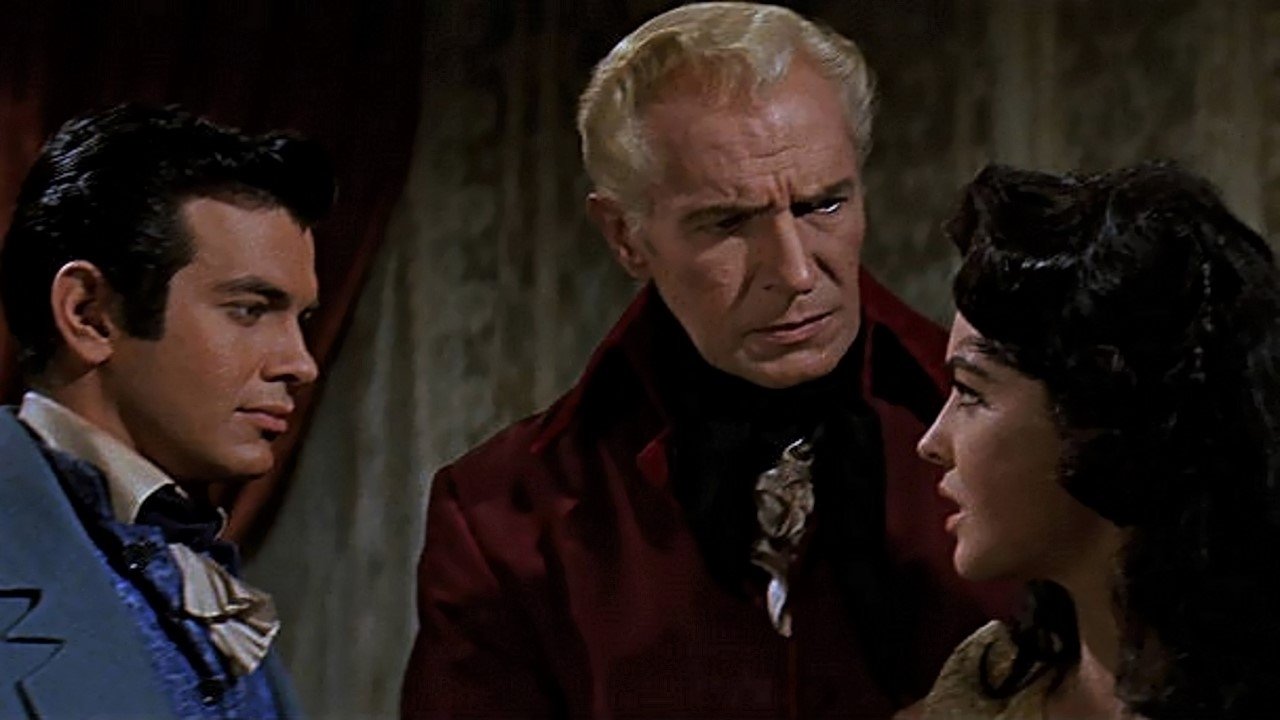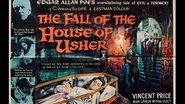Shawn Watson
Always a penny-pinch, Roger Corman made a modest budget of around $300,000 go far with this Poe adaptation. Instead of two low-rent black and white trash movies he convinced the money men to let him do a single, prestige picture in color and Cinemascope. They agreed, but there is really not a feature-length story here, and it limps across the 79-minute mark gasping and wheezing.Well-to-do Philip Winthrop arrives at the gloomy House of Usher to whisk his fiancée away to a new life in Boston. Her brother Roderick (a blonde Vincent Price) objects to it, claiming that the Usher bloodline is doomed to misery and that the dark, old house won't let her leave. Er...so how did they meet in the first place? Philip imposes himself on the household and discovers that they are all indeed quite mad. Had he been a little older and wiser he would have realized that no woman is worth that trouble and rode right on out of there. But then we wouldn't have a movie, or what has been stretched out into a movie.The pacing, sets, and morbid atmosphere all feel very similar to Pit and the Pendulum, which Corman and Price did a year later. Had I not been recently familiar with that movie then perhaps Fall of the House of Usher might have had a better effect on me, but they are both so alike that I felt like I was watching the same movie twice. It looks pretty and the aching, wobbling house is a wonderful location with a brooding, foreboding gloom surrounding it, but there simply isn't enough for this quartet of characters to do.
GL84
Arriving at his fiancee's mansion, a man looking to retrieve her to be married together finds that her controlling brother is trying to remove him before a terrible family curse takes hold of them and tries to ensure her safety before it can come to pass.This is one of the best in the Corman/Price/Poe series. Being the official start of the series, the Gothic atmosphere surrounding the film is completely overwhelming and at times can suffocate with it's dread. There's numerous encounters here filled with old, creaky caskets, a long, winding staircase into the darkness and cob-webbed decor surrounding the rooms while featuring candle-lit lighting and large, opulent splendor that's bright and spacey that solidifies its true Gothic mindset. That goes hand-in-hand with the fact that the castle grounds are in the traditional Victorian style on a fog- covered grounds, dark dead trees, musky swamplands and it makes the sequences showing it pretty spooky. Likewise, the curse befalling the family is quite chilling with the line of history and how it's doomed to repeat itself makes for a great revelation that jumps off quite fittingly from the house's location and surroundings into the big plot-point about her being accidentally buried alive in order to fulfill the family curse. That as well leads into the film's great action scenes, where their first trip in the basement is a great set-piece that has a great shock effectively using a skeleton in the casket while a dream sequence also comes off rather well as it's pretty creepy for the time and actually came as a surprise. Still, it's the final half hour which scores so well here as that is one continuous Gothic set-piece with the banging doors, the blaring thunderstorm in the background and the thrilling resurrection that is cleverly done showing a close-up following of a blood-trail along the floor out of the crypt back into the house and leading into the big final fight that make this a spectacular series of events. The conflagration at the end is an only more than appropriate ending, as it's action-packed and suspenseful in its own way, serves itself well with the great brawl for the Gothic-styled revenge which is a great ending to the series of events and ends it on a high note. Perhaps the best part, though, is Price's creepy performance as Roderick Usher. He gives one of his best performances, being creepy, mysterious and fun to watch as well and is certainly a career highlight in that respect. These here make this quite a spectacular effort that does have more than enough to overcome the one minor flaw in here. There is really only one thing that holds this back as every new and then, Price's constant speeches about not understanding the Usher curse got old. It wouldn't take up that much to officially explain what happened, and it would take away from the speeches and get to the story, so that kind of sticks out here. Though some may have a problem about how close it is to Poe's story, that's of a viewer-discrepancy issue rather than anything to do with the actual film itself and really isn't a detriment like the other factor is.Today's Rating/PG: Mild Violence.
AaronCapenBanner
The first of Roger Corman's Edgar Allan Poe Adaptations opens with a stark, ultra-bleak landscape, as Mark Damon plays Philip Winthrop, who arrives on horseback to see his love Madeline Usher(played by Myrna Fahey) only to be told by her brother Roderick Usher(Vincent Price, superb) that she has fallen into a catatonic state, and he is afflicted with overly acute senses, rendering him listless. Apparently, the Usher's are under a curse that has finally taken affect on them, and their mansion. Philip refuses to believe this, but stays in hopes of helping Madeline, though events will prove to be beyond his control...First-rate adaptation of the memorable short story is atmospherically directed by Roger Corman and well written by Richard Matheson, both conveying well the palpable sense of gloom and decay that has afflicted the Usher estate. A bit slow at times, but a minor quibble in such a striking film.
James Hitchcock
"The Fall of the House of Usher" was the first in a cycle of films based on the works of Edgar Allen Poe and made by Roger Corman between 1960 and 1964. (All but one of these starred Vincent Price). As with some of the later entries in the series, Corman makes a number of changes to Poe's story. Poe never explicitly states where the action of his story takes place, but his references to the house being many centuries old suggest a location somewhere in Britain. (In his lifetime few American houses would have been older than a century, and none older than two centuries). The film, however, is explicitly set in New England, with the explanation that the house was dismantled and re-erected across the Atlantic when the Ushers emigrated. Poe's nameless narrator is invited to the house as a boyhood friend of its owner, Roderick Usher. Here he is given the name Philip Winthrop and is the fiancé of Roderick's sister Madeline. In the story Roderick and Madeline are twins, but here Roderick is a middle-aged man considerably older than either his sister or Philip. In the original Madeline only appears briefly before her death, but here she is given a more important role. Most importantly, Corman introduces a moral theme not found in Poe. (He was to do something similar in a later Poe film "The Masque of the Red Death", where the innocent young girl Francesca is introduced so that her goodness can act as a foil to the villainy of Duke Prospero).Poe's Ushers were a distinguished family, noted for their charity and their patronage of the arts; there is nothing to suggest that the decline in their fortunes is in any way connected with their moral character. Here, Roderick and Madeline are the last survivors of a family notorious for wickedness, cruelty and vice, many of whom went mad, and it is implied that their evil has blighted the surrounding countryside and suffused the very walls of the house itself. Poe used the phrase "fall of the house" in a double sense, referring to both the decline of the family and the physical collapse of their home. The film does the same, but with the implication that this "fall" is the natural result of, and a just reward for, centuries of evil living. Despite its divergences from Poe's plot, however, the film still keeps an essential feature of his story, namely the atmosphere of psychological terror which pervades it. Much of this is due to the performance of Vincent Price (Neither Mark Damon as Philip nor Myrna Fahey as Madeline makes much of an impression). Like Poe's character, Price's Roderick is a man prey to all sorts of fears- he is hypersensitive, a hypochondriac, obsessed with the evil deeds of his ancestors and tormented by the idea that, like them, he is doomed to madness. He believes firmly that if Philip succeeds in his intention of taking Madeline away from the house some unspecified evil will follow. The Madeline we see in this film, unlike her counterpart in the original story, initially seems physically and mentally healthier than her brother, but it quickly becomes clear that she has health problems of her own, and that she may also be in danger from another source.This was the first film which the studio, American International Pictures, made in colour. AIP had only been founded six years earlier, and had hitherto specialised in low-budget black-and-white movies, often aimed at the teenage market. "The Fall of the House of Usher" was made on a rather higher budget than most earlier AIP films (although still lower than the average film of this period) and was clearly aimed at a more prestigious market. In some of his later Poe adaptations, such as "The Masque of the Red Death", Corman was to reveal himself as a master colorist, but here the use of colour does not really add anything, and it struck me that this is a film which might have been better had it been made in black-and-white. Certainly, monochrome photography was becoming unfashionable in the American cinema in the early sixties, but films like "The Haunting" from three years later show that it was still possible to make effective black-and-white horror movies during this period, and Poe's story might have benefited from a similar expressionist treatment. The exterior scenes of the old house might also have seemed more convincing in black-and-white. Another visual element I disliked was those curious paintings of Roderick's ancestors, as their crude, modernistic style seemed very inappropriate given that the action is supposed to take place during the 1830s or 1840s. "The Fall of the House of Usher" has some similarities with the last film in the Poe-Corman cycle, "The Tomb of Ligeia"; in both films there is a certain ambiguity as to whether the characters really are threatened by supernatural evils or whether these evils only exist as fears in the mind of the Vincent Price character (called Verden Fell in the later film). I would not rate it quite as highly as "The Masque of the Red Death", but overall, it is a pretty good film, a good example of the "understated" style of horror. ("The Haunting" is another such). The actual horrors which we see on screen are less important than the unnamed horrors which are hinted at but not shown directly. 7/10


 AD
AD







